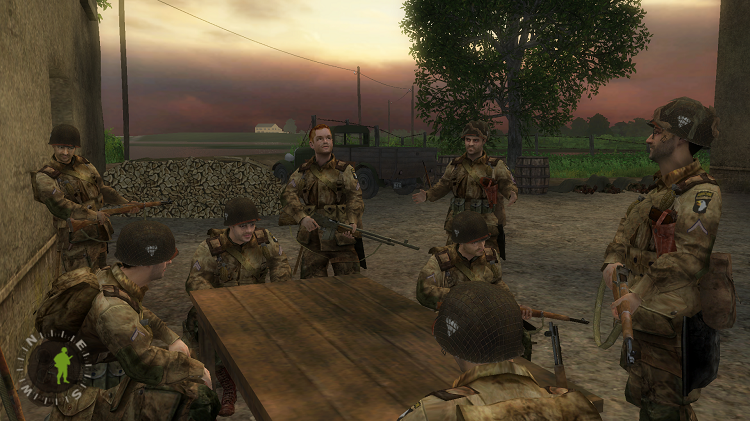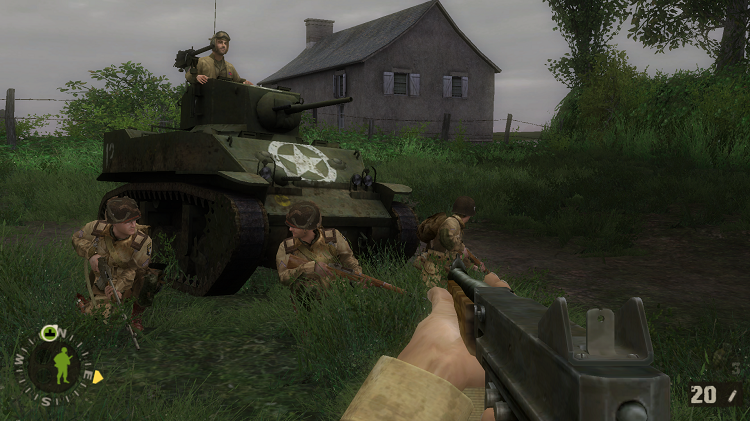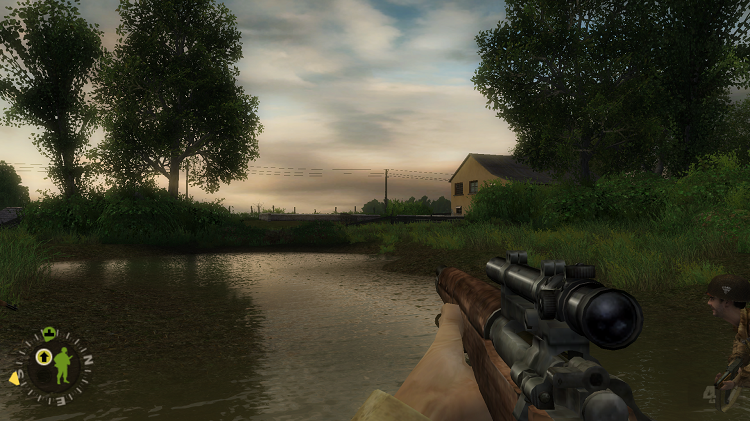|
In the glut of World War II shooters that followed in the wake of Saving Private Ryan and Band of Brothers, it could be difficult for a game to be distinctive. With their first original project Brothers in Arms: Road to Hill 30, Gearbox Software used an increased focus on realism and small-unit tactics to help them stand out from the crowd.
Today, the tight focus of Brothers in Arms and its strong emphasis on commanding troops helps the game overcome its dated technology and some clear shortcomings in its story and setting. Thanks to the success of the game and its sequels, Gearbox gradually outgrew their status as a developer-for-hire and became a major studio in their own right. Without this game, their subsequent projects like the blockbuster Borderlands series would likely not have come to pass. Whatever your feelings about co-founder Randy Pitchford, Brothers in Arms makes a good case to be a highlight of the original wave of World War II shooters.
When Brothers in Arms was released in 2005, it was far from the only game of its kind on the block. Return to Castle Wolfenstein (2001), Medal of Honor: Allied Assault (2002) and Call of Duty (2003) had all beaten it into the fight and had won strong sales and critical plaudits in the process. Gearbox needed some distinct elements to secure their place in history; among these are the game’s tight historical focus and its efforts to tell a compelling story.
Whereas other World War II shooters of the time range around a number of locations and scenarios within the conflict, Brothers in Arms is far more specific. Its 20 missions take place entirely in the days immediately following the D-Day landings in June 1944. This focused portrayal of the invasion of Normandy has its pros and cons; the depiction of the region is meticulous and convincing, but the locations become quite rote and over-familiar by the game’s end. At its worst, Brothers in Arms can feel less like a war, and more like an armed squabble over French farmhouses, like A Place in the Sun with guns. The game has a larger emphasis on narrative than many comparable games of its era. Transparently influenced by Band of Brothers, it focuses on specific squads of the 502nd Parachute Infantry Regiment of the U.S. Army. The player takes on the role of Sergeant Matt Baker, and commands a number of troops tasked with securing key positions in Normandy. Unfortunately, the game’s attempts to build its characters and to tell an emotive story fall completely flat. The various soldiers have barely any distinguishing features, the voice acting is poor, and the story beats are eminently predictable. Pitchford aimed to get players invested in the fate of their comrades, but this is entirely destroyed by dead soldiers magically returning to life at the start of the next mission. It may portray wartime Normandy convincingly, but in narrative terms Brothers in Arms fails its mission completely.
The game is far more successful in terms of gameplay - but in this area Gearbox made some bold decisions which will not please all players. Critically, with Brothers in Arms the developers aimed not just to encourage a squad-based, tactical style of play - they took steps to actively enforce it. Working closely with the AI squads and tanks provided is essential because the player, as an individual, is hobbled in a number of significant ways:
In the allied AI soldiers, Gearbox do provide a counterbalance to these major disadvantages imposed upon the player. These troops may be cardboard cutouts lacking any personality, but they are efficient operators who normally respond swiftly to the game’s simple system of orders - move here, suppress this target, assault that target. This style of play takes some getting used to, but eventually the unit comes to feel like a well-oiled machine that compensates for the player’s fragility. Arguably, it becomes too efficient - because the German troops almost always use the same kinds of defensive positions, the same flanking maneuvers work time and again without modification. This growing predictability is another of the game’s flaws, but is mitigated to some extent by the brevity of the campaign.
If Brothers in Arms is one of the less well-remembered World War II shooters of the early- to mid-2000s, it may be partly because the game hasn’t dated particularly well. The graphics were merely average by the standards of 2005 and the game’s look is lacking in distinctiveness. The superb and underrated Return to Castle Wolfenstein (2001) looks at least as good, in its own way, despite being much older. Aesthetically, as in plot terms, Brothers in Arms is just too obviously indebted to Band of Brothers and Saving Private Ryan to stand out. This same issue extends into the sound, with the minimal music being as generic “World War II heroic” as it is possible to be.
Brothers in Arms is no masterpiece. It was released in a crowded field, and certainly is not the best example of its general type. It is repetitive, lacking in a distinctive look and an abject failure in terms of storytelling. With all this being said, it is still a compelling and worthwhile experience. While it many ways it merely followed the standard template set out by TV, film, and other games, in other ways it genuinely blazed its own trail. Gearbox made bold, controversial design decisions which create a specific kind of intensity which other World War II games often lack. By emphasising and imposing the need to work closely with AI squads, Brothers in Arms puts a distinct spin on the tired formula of the FPS. Other games have attempted the same thing, but few so elegantly. If Gearbox had provided a compelling story and characters, then their game might be remembered as a true classic. As it is, it is an intriguing oddity which is a must-play for fans of World War II shooters.
0 Comments
Your comment will be posted after it is approved.
Leave a Reply. |
About
I write about classic science fiction and occasionally fantasy; I sometimes make maps for Doom II; and I'm a contributor to the videogames site Entertainium, where I regularly review new games. Categories
All
|


